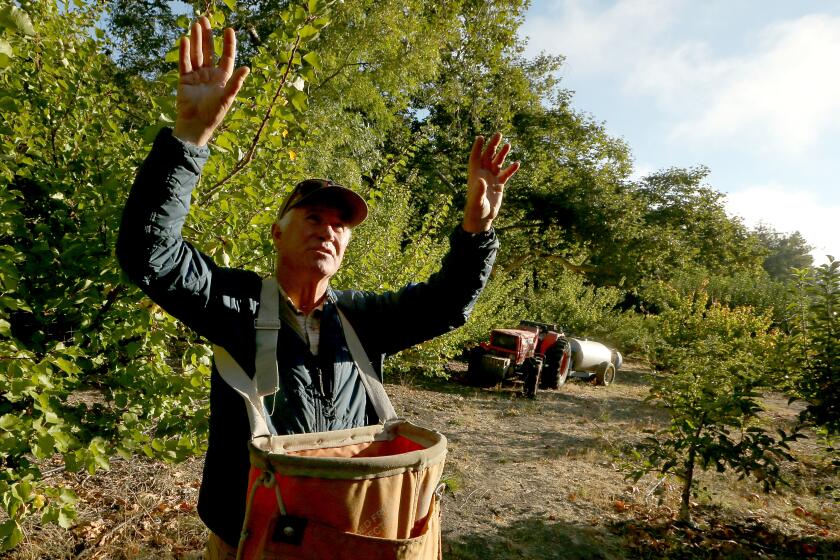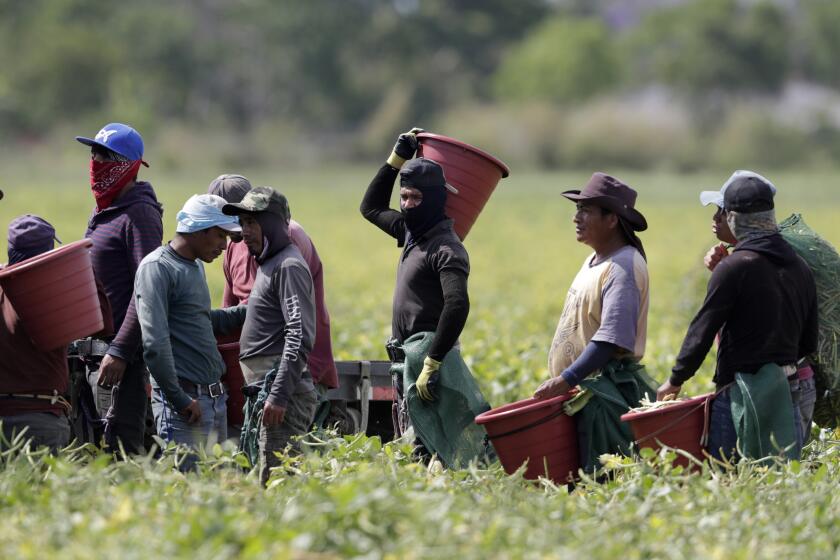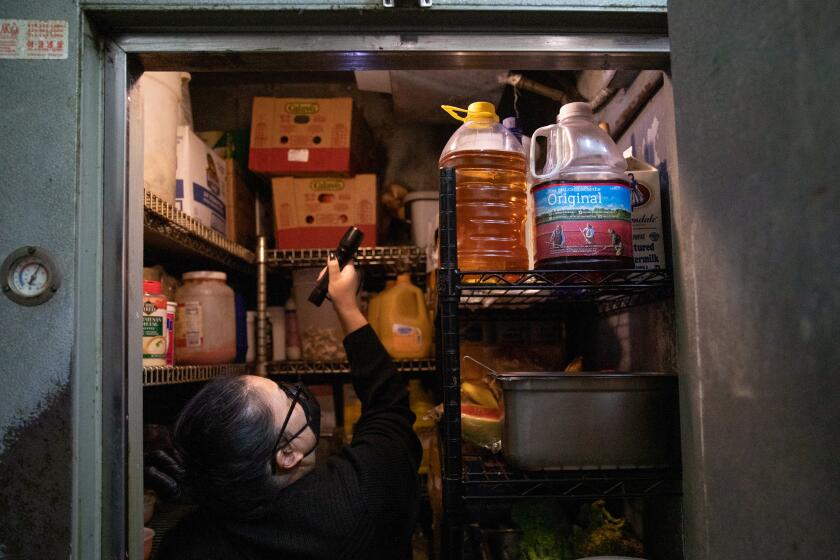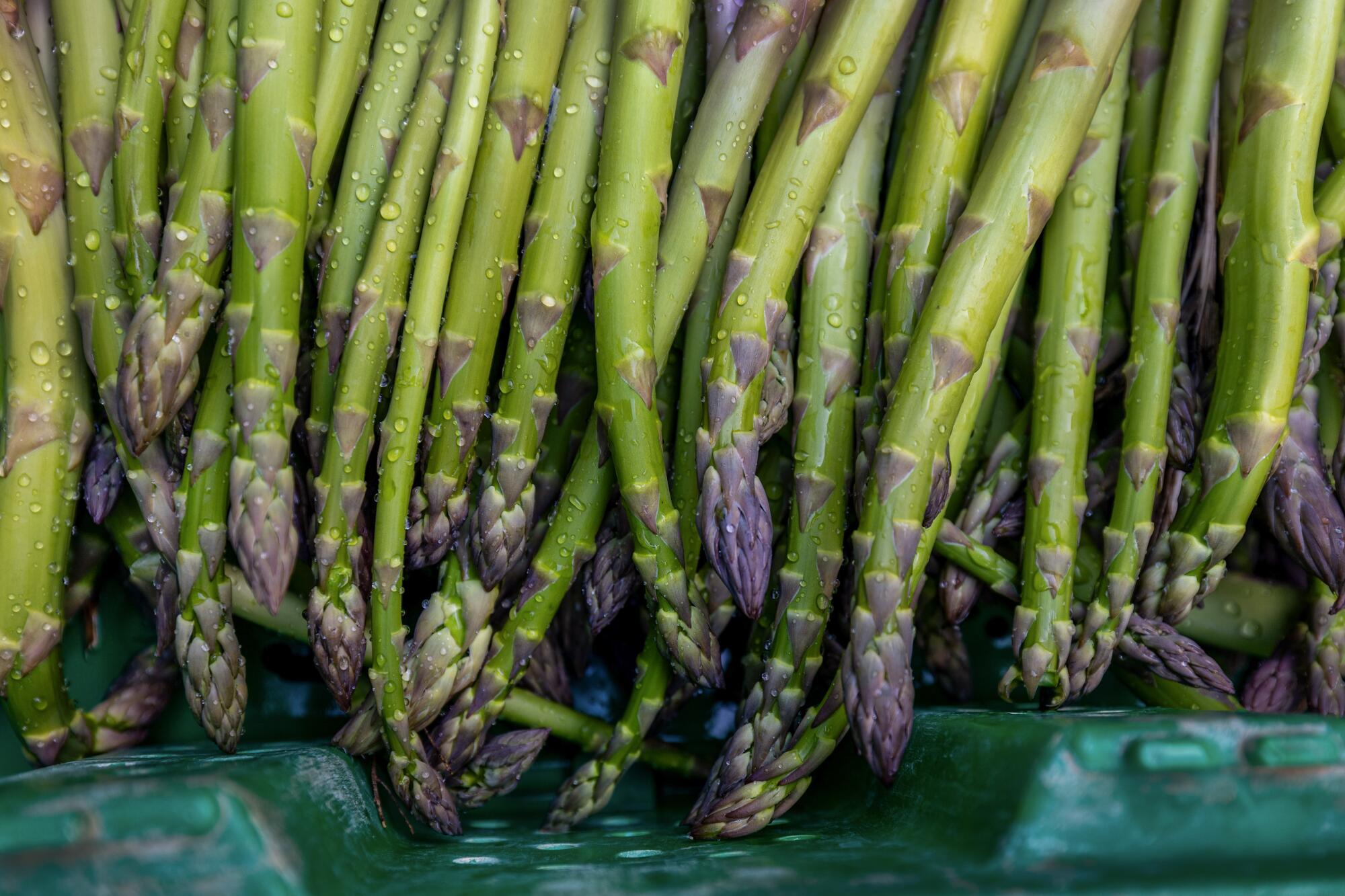
- Share via
FIREBAUGH, Calif. — It was a late March morning and dozens of women and men descended on a San Joaquin Valley asparagus farm — one of the last in the state. The workers walked along the furrows, cutting the newly sprouted spears at precisely nine inches, a market standard.
Later that day, farmer Aaron Barcellos surveyed the land peppered with the perennial that for many announces the arrival of spring. He is one of the last producers standing in California, a fourth-generation farmer who co-owns A-Bar Ag Enterprises in Firebaugh.
The 59-year-old picked a firm stalk from the ground. He pointed to its tightly braided tips and beefy stem.
“This is beautiful ‘grass,’” Barcellos said, a nickname growers often use for asparagus, although it’s not considered a true grass.
“Every spear of asparagus you see in the store is hand cut by an individual,” he said, referring to his own 120 workers.

Aaron Barcellos, who runs A-Bar Ag Enterprises in Firebaugh, Calif.
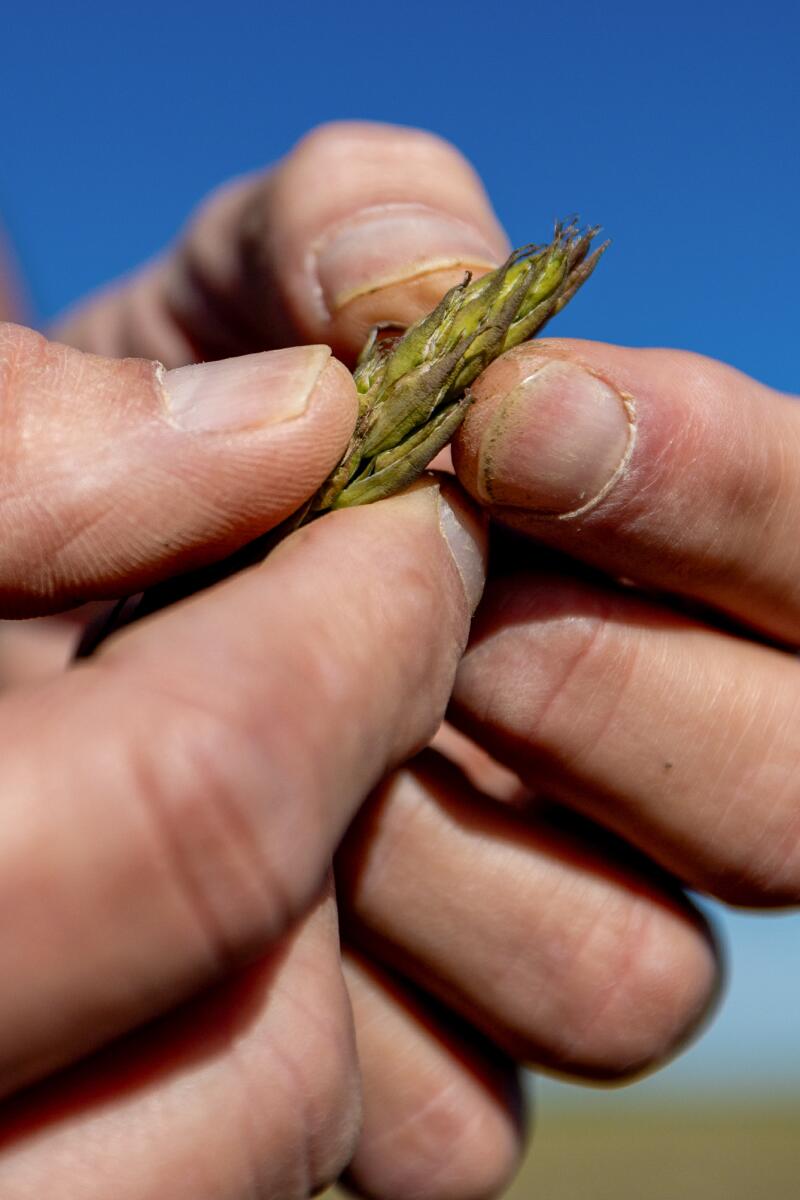
Barcellos inspects an asparagus spear on his farm.
The labor required to harvest the crop is partly why Barcellos fears for the future of asparagus. Once considered the king of vegetables in California agriculture and a seasonal delicacy exported worldwide, asparagus is on the decline here — the industry succumbing to the pressures of the global market, largely because of labor costs.
At its most recent peak in 2000, California farmers harvested 37,000 acres of asparagus, according to the state Department of Food and Agriculture. About 10% of that acreage has been lost every year since. Now there are fewer than 3,000 acres of asparagus left in the Golden State, according to the latest available data.
Vintners and conservationists in Valle de Guadalupe are concerned that a tourism boom and water scarcity will lead to disaster.
Even the annual San Joaquin Asparagus Festival has been affected. This year, only one local farm provided spears for the cooking demos and Asparagus Alley, where festival-goers indulge in such treats as deep fried asparagus and asparagus ice cream.
How this happened can be read as a cautionary tale for California agriculture at large, farmers and asparagus industry insiders said.

Currently, just three conventional or non-organic farmers produce the bulk of California’s asparagus. A-Bar Ag Enterprises grows asparagus on about 225 acres. It co-owns R&N Packing with the Turlock Fruit Co., which produces asparagus on another 225 acres of land. Both farming operations are located in Firebaugh. About 100 miles north in Stockton, Klein Family Farms grows a couple hundred acres.
Organic or smaller-scale farmers round out the rest of the crop’s presence in the state. At Durst Organic Growers in Esparto, Jim Durst harvests organic asparagus on 150 acres. His spears are sold at Whole Foods Market, Sprouts Farmers Market, Raley’s and other grocers in California. Victoria Island Farms in Holt, Calif., near Stockton, also produces asparagus; it is mostly sold at its farm stand. And Zuckerman Family Farms in Stockton still produces some asparagus but stopped selling its prized jumbo spears at farmers markets in Los Angeles more than a decade ago, Roscoe Zuckerman said.
“Asparagus is one of those crops that’s really taken a beating,” said Chip Arnett, who has observed the industry over the last 40 years. He operates Mister Spear, which buys premium California asparagus from the field and ships it to consumer homes overnight or within 48 hours. “It just gets to the point where many of these farmers asked themselves, ‘Is this really worth it?‘”
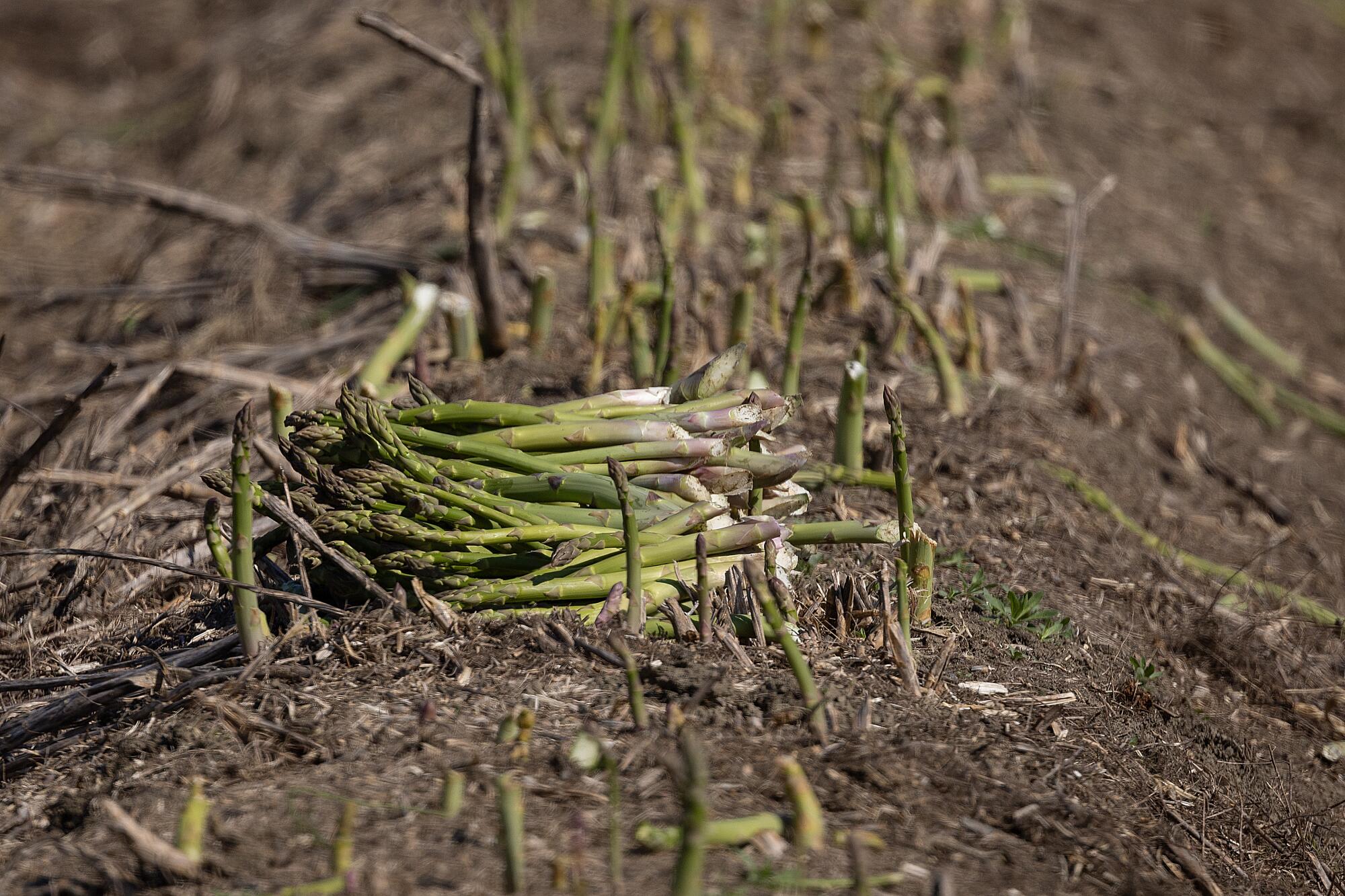
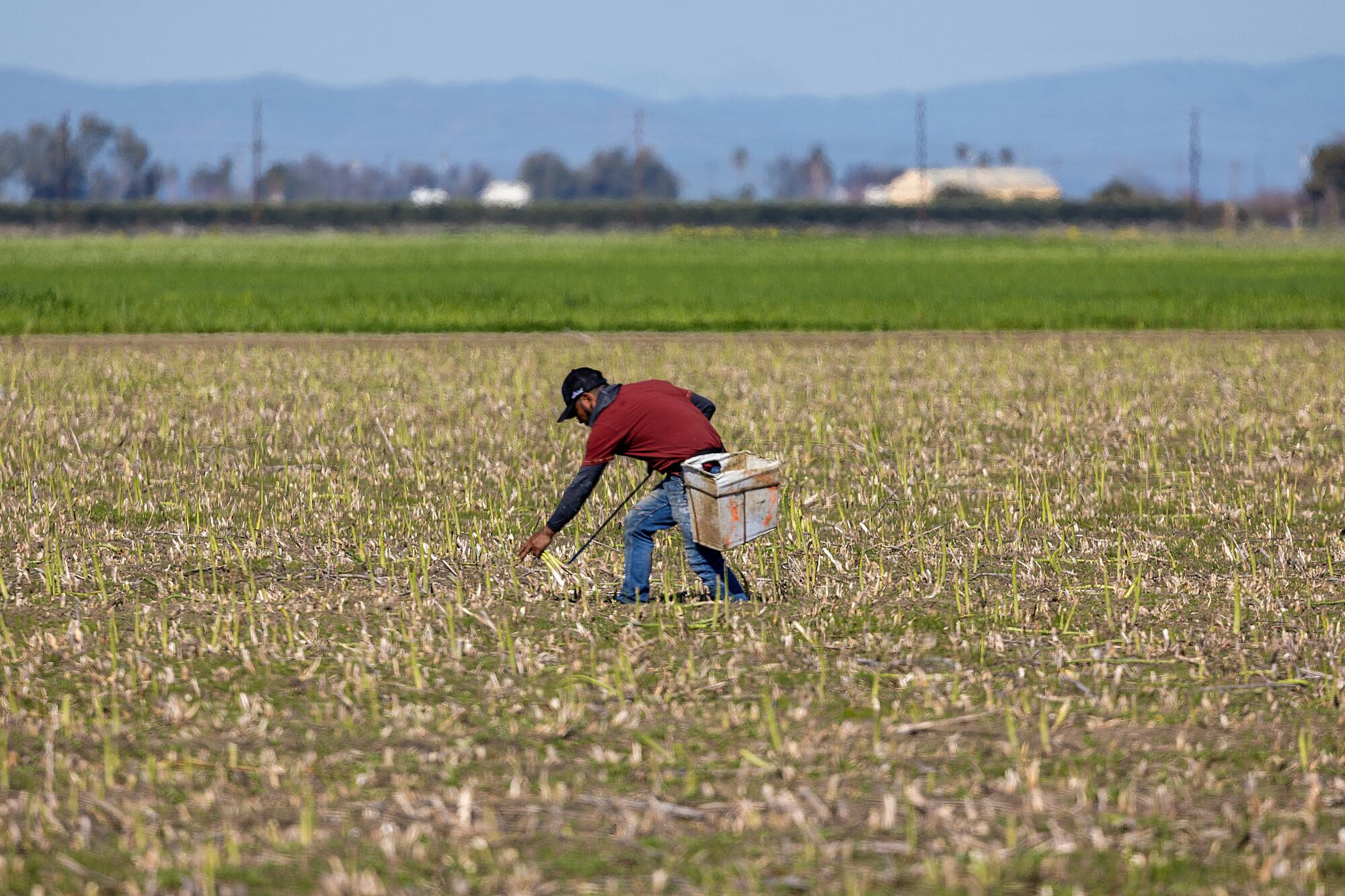
Ceaseless harvest
Firebaugh’s asparagus is generally characterized by its unmistakably thick stem, in contrast to the pencil-thin stems common to imported asparagus. It’s also grown in Washington state and Michigan. The vegetable is grown all over the world, with China as the largest producer, although it doesn’t export much of it.
The quick-growing plant must be harvested every day of its three-month growing season. The state’s varied microclimates allow for fresh asparagus from January through May. Each plant has an underground crown that sprouts multiple spears a day, and they have to be individually hand-cut.
Sporting hats, hooded sweatshirts and bandannas to shield themselves from the warm March sun, harvest workers at Bercellos’ farm walked the furrows and carefully combed the soil for nine-inch-long shoots. They stooped to cut the right-size stalks at the base with a sudden jab of an asparagus knife, a tool that resembles a fireplace poker with a forked chisel tip instead of a point.
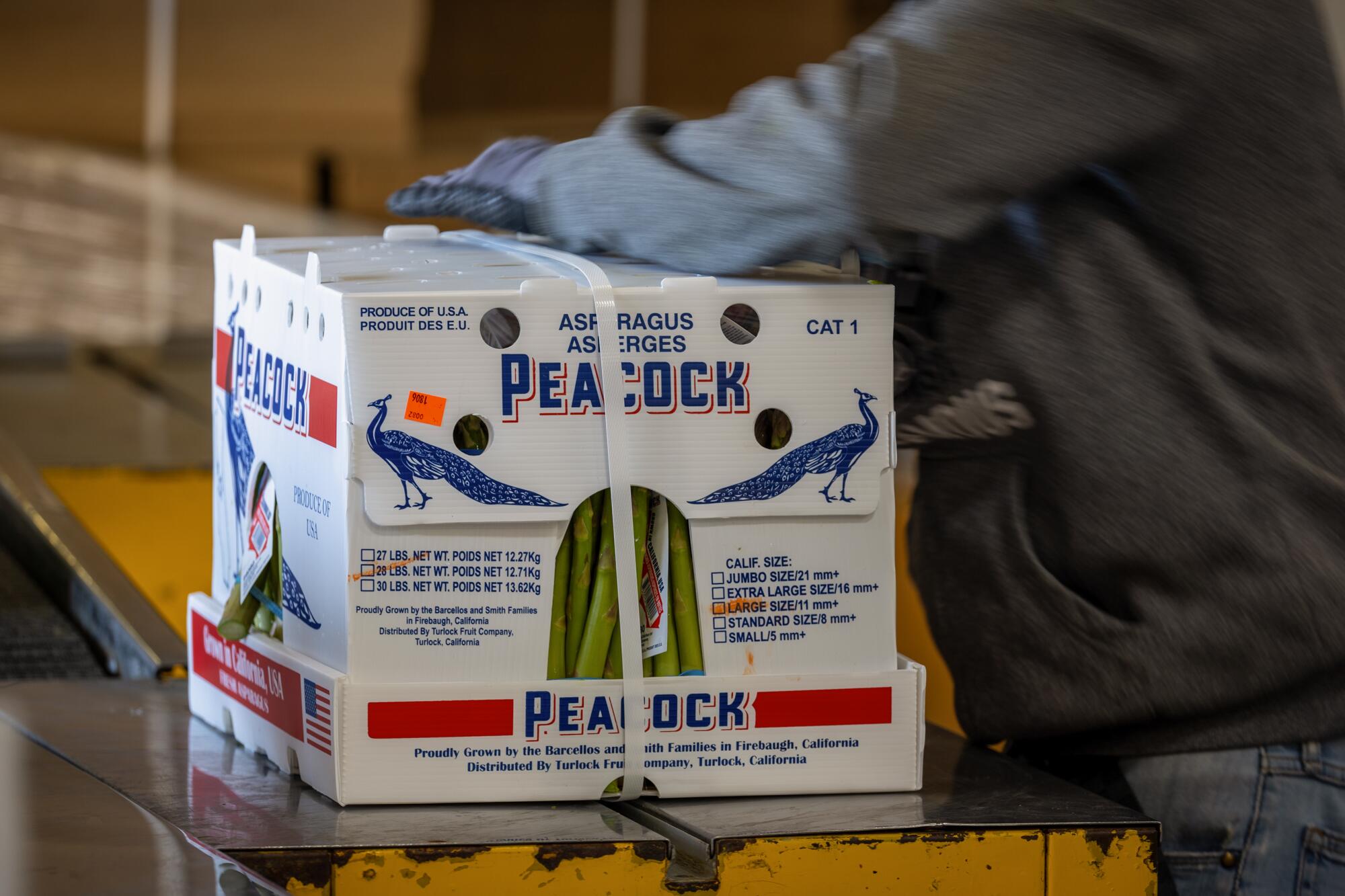
As the asparagus is harvested, each crown continues to push up new spears through the soil. This fast and constant growth allows farmers to harvest the same field up to 60 times during the growing season at some farms. On warm summer days, a spear can grow so quickly that workers will have to go back and cut a second time.
The harvest continues without stopping, seven days a week.
Some California growers specialize in dry farming, working with nature to grow apples and melons without irrigation. They tout the approach as a water solution.
The processing and packing of the vegetable is mostly done by hand too. The cost of labor to bring the crop to market is huge, accounting for about 75% of production costs in 2000, said Cherie Watte, who once served as president and director of the California Asparagus Commission, which suspended operations in 2019 in light of the crop’s decline.
“It’s like an exotic animal when you see it in the wild,” Watte said of California asparagus at mainstream California supermarkets.
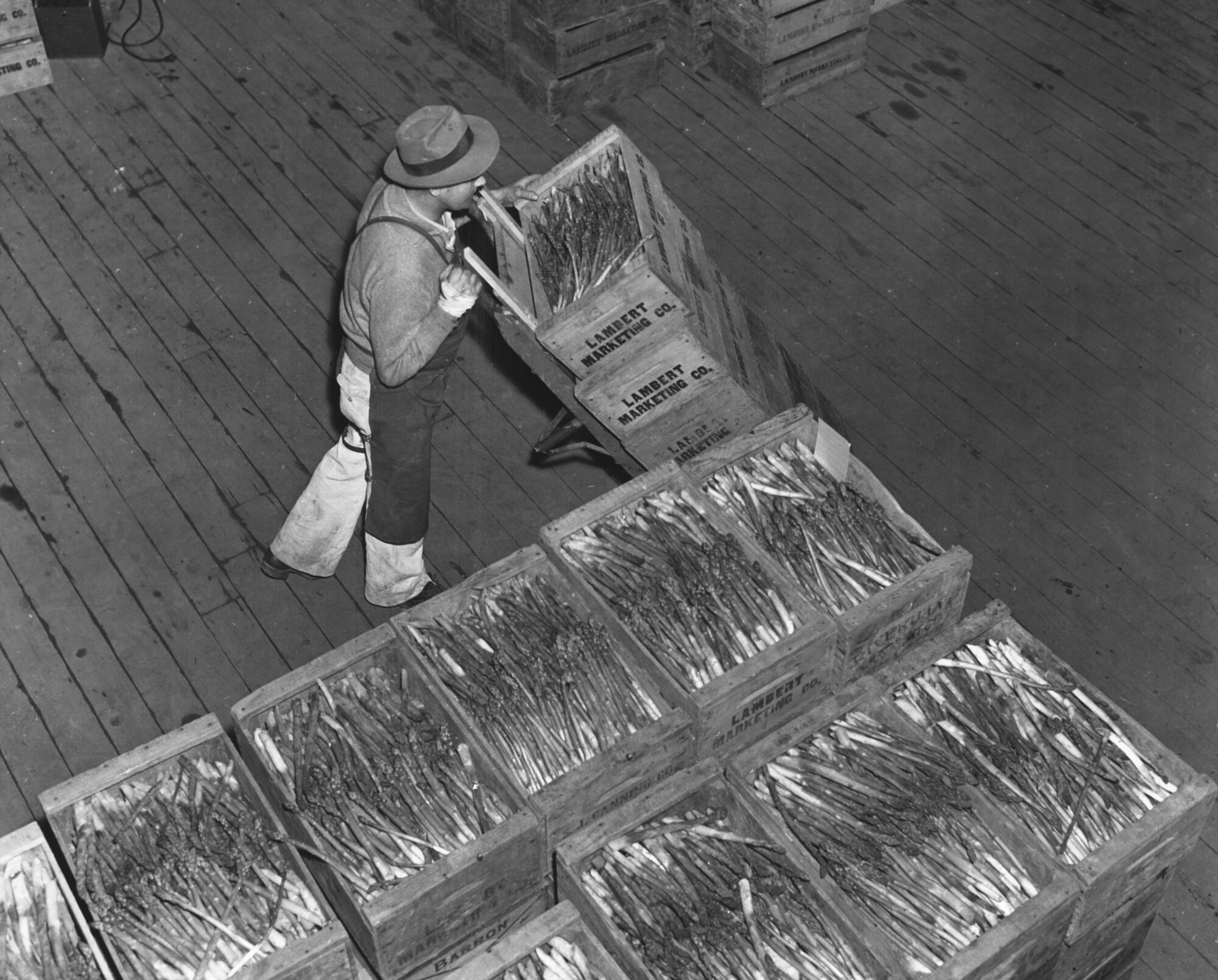
A rich history
Asparagus has a history that dates back to ancient Greece and Rome.
The vegetable arrived in North America in the 17th century and by the 19th century, commercial cultivation had begun in California. It grew particularly well in the nutrient-rich soil of the Golden State.
Historians believe the vegetable was planted first in the Sacramento-San Joaquin River Delta in the 1850s. The region became ideal for cultivation because the waterways provided fast, close shipping routes to the train depots in San Francisco and Sacramento. The peaty black soil in the delta made it the top asparagus-growing region in the state and — at one point — the nation.
Toward the end of the 20th century, trade liberalization agreements, particularly the North American Free Trade Agreement, better known by its acronym NAFTA — were a major factor in the decline of California asparagus, Watte and others said.
At the time of NAFTA negotiations, asparagus was identified as a sensitive commodity and, as a result, tariffs were reduced over a period of time. By 2000, the California asparagus industry had begun adjusting to increased import competition from mega-producers like Mexico and Peru. Asparagus farmers in the state invested in new varieties to produce higher yields and attempted mechanical harvesting technology.
“Unfortunately,” Watte said, “technology wasn’t advancing fast enough to outpace increased costs of production.”

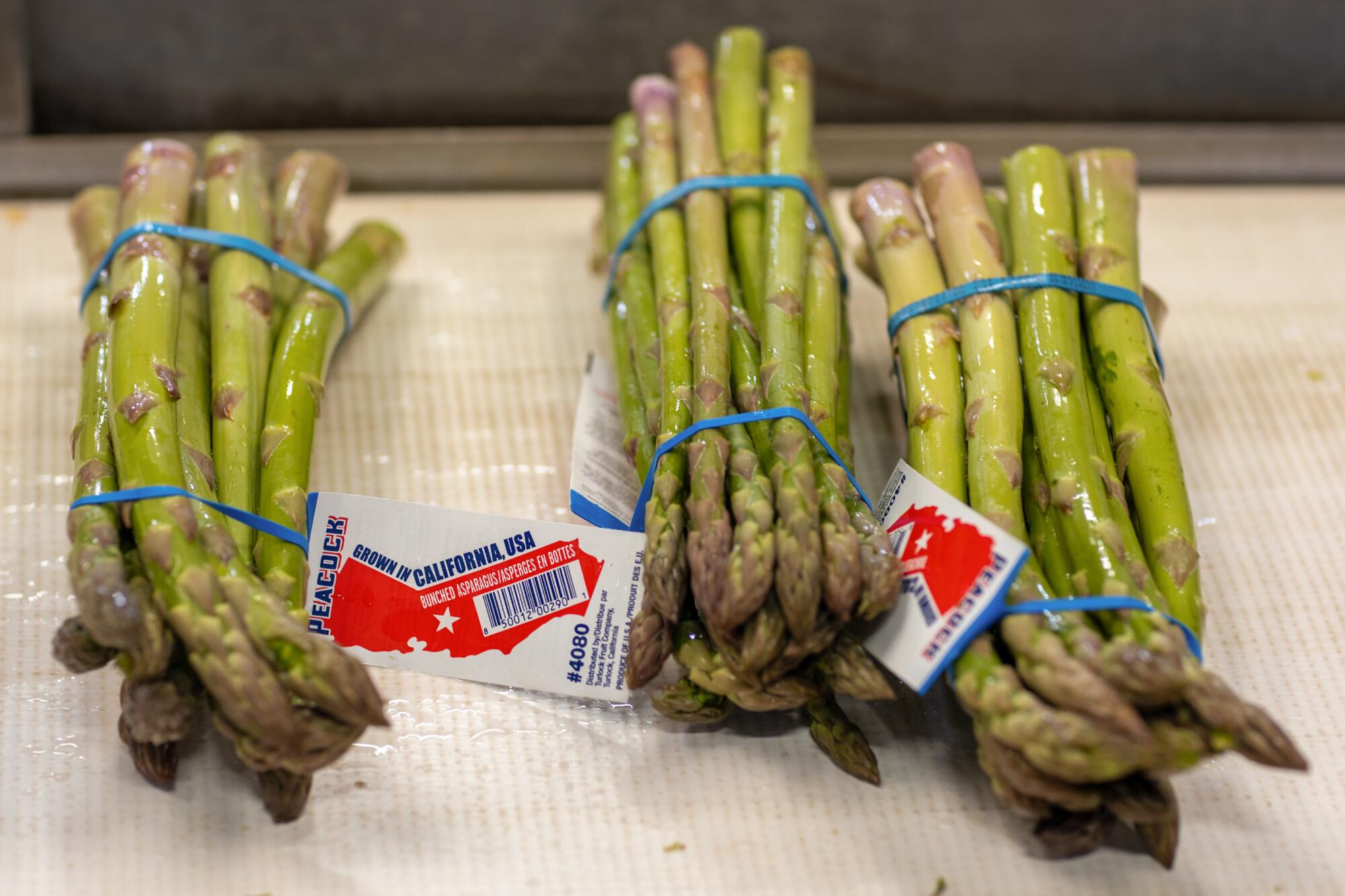
Worker costs climb
The state’s pro-worker regulatory structure is also a factor. Agricultural workers were once largely exempt from overtime pay. That changed in 2019, when California began phasing in overtime for agricultural workers, in a victory for the United Farm Workers, which spearheaded the measure at the time.
Two years later, the state legislation began requiring overtime compensation for agricultural employees who work for large employers and who labor more than eight hours a day or more than 40 hours a week. Watte said the overtime bill became a pivotal moment, particularly for farmers who grow labor-intensive asparagus. Farmers in turn cut back workers’ hours.
At the same time, Mexican farmers soon learned how to push asparagus nearly year-round and into California during the state’s harvesting season, which glutted the market, Watte said. And that meant farmers in California couldn’t get good pricing when their season started in March. It would become a formula for crisis.
The California Legislature held a hearing about ‘state failures’ regarding farmworker and meatpacking job conditions.
And asparagus isn’t alone. Currently, more than half the fruit and more than a third of fresh vegetables in the U.S. are imported, according to the U.S. Department of Agriculture.
Neill Callis, part of the family management team at the Turlock Fruit Co., said its operation has a small window to make a profit — from April to May — because Mexican farmers haven’t yet found a region that will produce asparagus during that period. That’s when the company can actually take home a profit and make up for losses during the rest of the growing season. But there have been years when the weather hasn’t cooperated, and the Mexican crop has come late or the California crop has sprouted early.
That’s what happened in 2005 and 2006 — dark years for asparagus.
“It was a bloodbath,” Callis said. Turlock Fruit Co. ended up literally dumping unpacked asparagus on the fields because the market was bad.
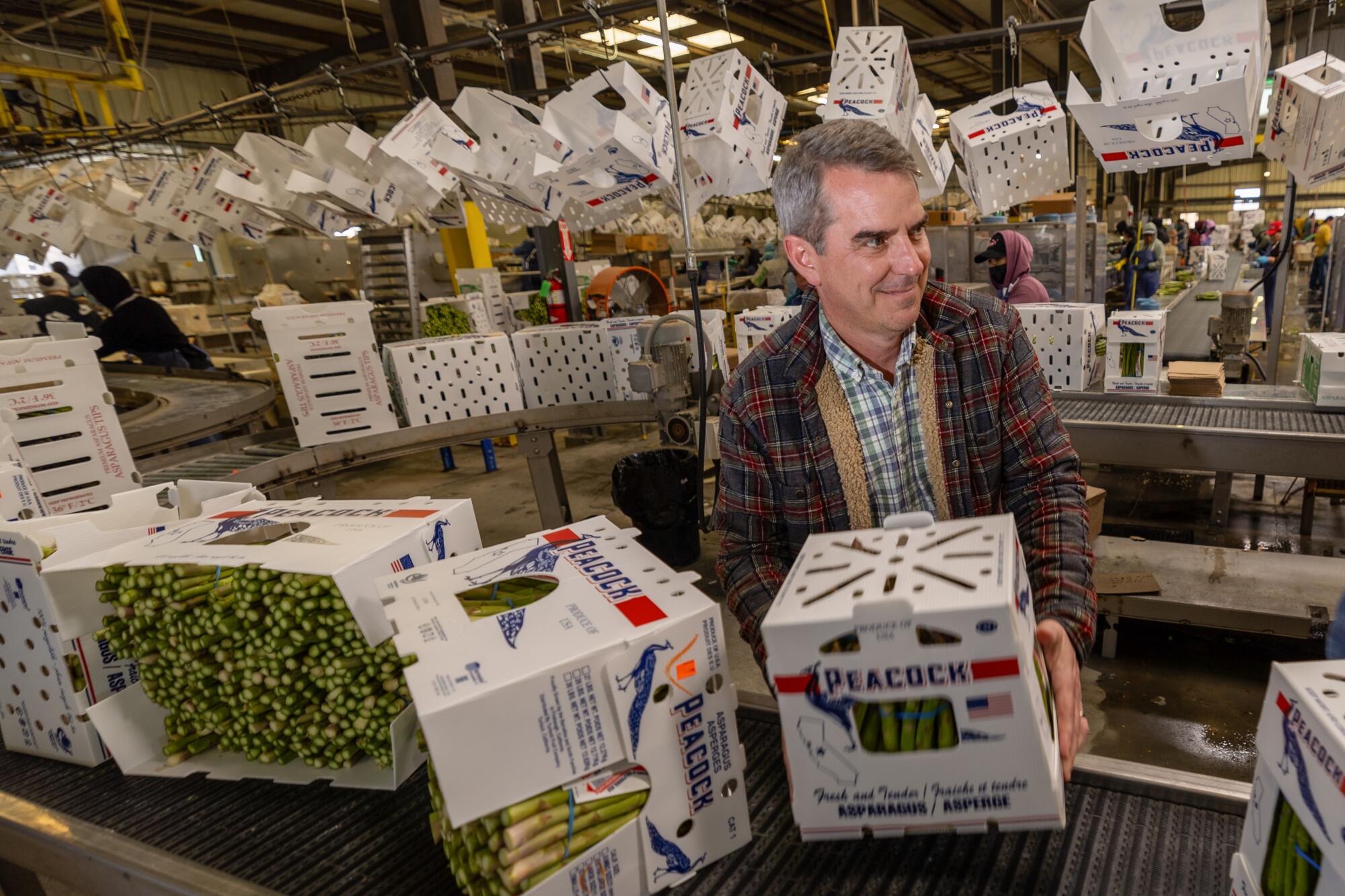
Barcellos’ great-grandfather started a dairy farm four generations ago. In the 1980s, Barcellos’ father sold it. Soon after, Barcelllos, his brother and father started another farming operation. The family farm now produces several crops, including asparagus, pistachios, cotton, olives, pomegranates and tomatoes.
In 2010, Aaron Barcellos purchased farmland that already had 125 acres of asparagus. He decided to expand it and at its peak, he grew asparagus on 400 acresof land.
Barcellos made money that first year or two but soon after, Mexican asparagus flooded the market. Two years ago, he scaled back and took a 170-acre field out of production, letting it go fallow.
On the other side of the coin is Craig Rolandelli, whose company pivoted from shipping California asparagus out to the world to importing foreign asparagus into the state. Rolandelli is chief executive of Jacobs, Malcolm & Burtt, which oversees the marketing and sales of several asparagus operations in Mexico and a few in Peru.
Every day a health inspector makes an unannounced visit at restaurants throughout Los Angeles County. What does it take to pass an inspection? Who makes up the rules and why? It’s a job facing high vacancy rates — but someone has to do it.
Rolandelli’s father, Leo Rolandelli, who ran the company for nearly five decades, was once dubbed the “Godfather of Asparagus” in California. Craig Rolandelli said in an interview that NAFTA is not to blame for California’s asparagus slump.
“I would blame it on the cost of doing business in California,” he said. “At $10 an hour, we were competing with Mexico. At $12 an hour, we were competing with Mexico.”
Once California’s minimum wage got over $12 an hour, Rolandelli said, it became too difficult for the state’s asparagus farmers to compete with Mexico, where the daily minimum wage is now about $14 . That’s about nine times less than a California worker makes at the current agriculture minimum wage of $16 per hour.
Barcellos said he would like to continue to grow the crop but it’s unclear how long he can hold on. He and Callis said they have to charge a premium price to cover their costs.
“Last couple years, we have pretty much broken even with asparagus,” he said. “We paid the bills but there isn’t any money left overas a profit margin.”
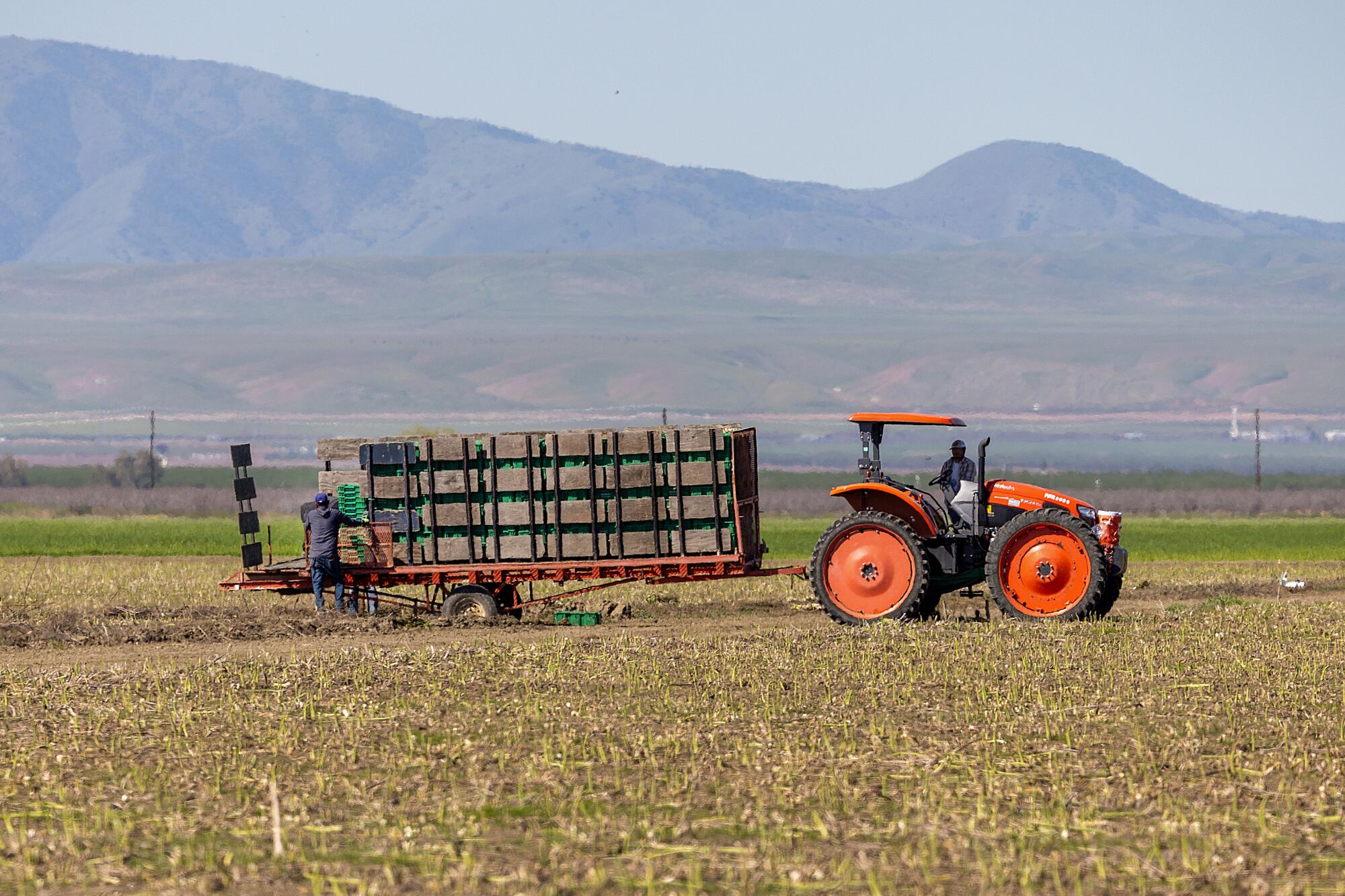
At a distance, Barcellos spotted the workers walking alongside a tractor, gingerly filling crates with young spears. The newly cut “grass” was bound for a packing shed where workers would clean it, sort it and box it under the Peacock label. It was destined to make its debut the next day in the produce section of a Publix supermarket in the Atlanta area, more than 2,000 miles away.
The decline of the local industry is apparent by the availability of California-grown asparagus at nearby grocers.
About a 20-minute drive northwest of A-Bar Ag Enterprises, at the Save Mart in Los Banos, a worker seemed puzzled when asked if the store carried local asparagus. She pointed to a cart across from a sign on a wall that read: “Central Valley Grown.” Inside were about a dozen plastic-wrapped packs of pencil-thin asparagus, priced at $5 a bunch.
“Product of Mexico,” the label declared. The thin shoots with dry stems were a departure from the vibrant, chunky spears at the A-Bar farm.
Barcellos, who lives in Los Banos, frequents that particular Save Mart. He said it’s discouraging to see his local market sell asparagus from hundreds of miles away when, he says, he grows a superior version just a few miles away. “It’s disappointing,” he said.
A Save Mart representative declined to comment and referred questions to the California Grocers Assn. Nate Rose, a spokesperson for the association, said the grocery stores the organization represents do their best to buy from local farmers when possible but can’t always do so because of supply and cost.
Rose said the grocers the assocation represents are unable to “source a sufficient supply in-state to keep up with consumer demand for year-round produce availability and pricing expectations.”
Rose added that grocers operate on extremely slim profit margins, averaging just about 2.2%.
“So procuring products for a price that satisfies customers while allowing grocers to keep their doors open,” he said, “is essential.”
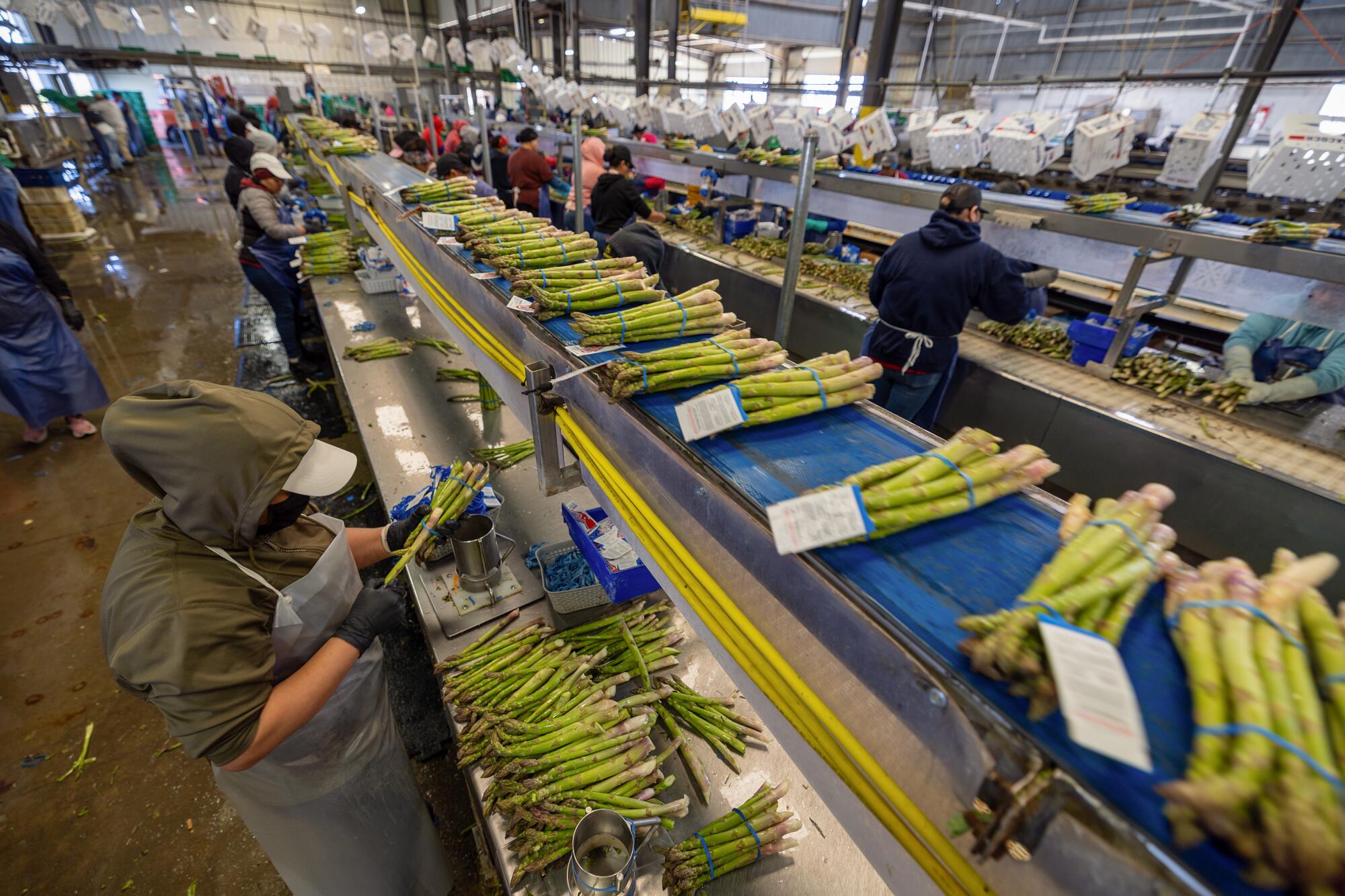
Tough labor market
At the packing shed west of Firebaugh, workers began the regimen of attentively washing and sorting the asparagus for market. Much of it is sized and sorted by hand and refrigerated to 36 degrees, which slows down all post-harvest biological processes. If not refrigerated soon after packing, asparagus spears could actually continue to grow in transit.
Maria Pineda, 56, is a worker at the Turlock Fruit Co. and has labored in asparagus packing sheds since 1996. A native of El Salvador, she laments the demise of the vegetable that’s helped her provide for her family.
Pineda gets paid $16 an hour and no longer works much overtime. Her hours have been cut back since the overtime laws took effect.
Although she believes that legislators may have had good intentions in trying to look out for her and other workers’ welfare, she said the law ended up hurting her. She used to work 10- to 12-hour days, making more money then than she does now and was able to better provide for her family.
At last, after nearly 10 years, Karla Vasquez’s “The SalviSoul Cookbook” is being published by Ten Speed Press with terrific Salvadoran recipes you’ll want to make and stories of the women who shared them.
“I want to work more hours,” she said. “This overtime law doesn’t benefit me, because I’m working fewer hours. I’m making less money a month.”
As a result, Pineda now has to have a side hustle, selling quesadillas — a Salvadoran sweet bread — to make up for the loss in income. She said she prays that California asparagus won’t go extinct.
“I wouldn’t have a job” if asparagus went away, she said. “If I don’t have work, how will I survive?”
Aaron Barcellos said he is kept up at night by the uncertainty of being a farmer — of any crop. The calculations he makes over the future of asparagus or the farm reflect the tensions that plague nearly all farmers in the state.
He holds onto an adage left by his father, Arnold Barcellos: “It’s never as bad as you think, and it’s never as good as you think.”
Next year, he said, he still plans to harvest and sell asparagus.
More to Read
Eat your way across L.A.
Get our weekly Tasting Notes newsletter for reviews, news and more.
You may occasionally receive promotional content from the Los Angeles Times.

